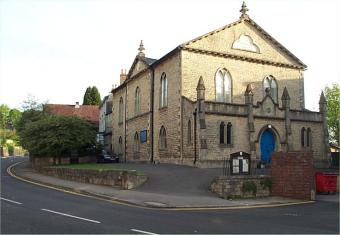

 |
 |
||||||||
| The Tabernacle, Dursley | ||||||||
|
The Tabernacle in Dursley dates from the non-conformist era of George Whitefield, a time when dissention in Gloucestershire was widespread and unhappy groups continued to break away from the Established Church. George Whitefield was born in 1714, studied at Oxford and went on to become a companion of George and John Wesley whose beliefs he shared. He was ordained a priest in 1739 and went on to preach throughout the country although his enthusiastic style brought him much opposition. He was able to speak equally to all, nobleman or maid, and gained a tremendous following for his energy and ability to captivate an audience. |
||||||||
 |
In 1743, Whitefield came to Dursley and preached to thousands. One of his friends, Thomas Adams, had started a religious society at Stancombe, near Stinchcombe, and this grew to be strong and influential. This society became allied with the English Calvanistic Methodist Association and Adams and a fellow preacher, John Dando, were instrumental in moving the Stancombe group to Dursley and establishing the Tabernacle. |
|||||||
| Dursley
Tabernacle, c1909 Courtesy Cam & Dursley Camera Club |
||||||||
|
The first Tabernacle, a name often used for meeting houses erected by George Whitefield's societies, was built on a site opposite the current one in Kingshill Road, probably around 1760. A further visit to Dursley by George Whitefield occurred in 1769, although by this time he was not a well man, but it is likely that he would have preached in this first building. The old Tabernacle survived until 1810 or so when it was pulled down, having been in a poor state of repair for some time. Some time prior to that, the land next to the site of the present Tabernacle was leased for use as a burial ground. Two years before the first Tabernacle did finally meet its end, work began on construction of a great new building, the current Tabernacle, and this was finally opened on August 22nd 1809. The inspiration behind this was the Rev. William Bennett who came to the town in 1804 and set himself the task of revitalising the society. In the subsequent years, Dursley has seen many changes in its fortunes and the Tabernacle has seen its fair share of these. In the 1820's some of the congregation began changing its following from Calvanistic Methodist to Independent or Congregational, and perhaps as a consequence of this, some of its most influential members decided to leave. They drifted off to hold meetings at the Hill Road Chapel and then their own chapel built in Boulton Lane. The Tabernacle was weakened by this and it wasn't until Rev. George Neeton came on the scene that the downturn was checked. This was followed in 1840 by a reunion with the Boulton Lane group amid great celebrations. |
||||||||
|
In 1861, a new hall, the Jubilee School Room, was added to the Tabernacle at a cost of £282. This was used to accomodate the Sunday School and by the end of 1862 there were 56 boys and 73 girls in attendance. Around the same time the burial ground was extended to relieve the cramped conditions that prevailed. This was further enlarged in 1890.
|
 |
|||||||
| Dursley
Tabernacle, May 4th 2003 Copyright Andrew Barton |
||||||||
|
By the late 1870's, complete renovation of the chapel was begun which saw the replacement of the galleries, ceiling, pews, flooring and pulpit together with the installation of a new heating system. In 1889, further classrooms were added behind the Jubilee School Room. Church life at the Tabernacle continued to flourish into the 20th century and not just on Sundays. Many different groups aligned themselves with the chapel or made use of the facilities, including a Boy Scout troop in 1908, one of the earliest in the country. Also during this period of its history, the Tabernacle had some very ardent and influential supporters in the town, including the brothers George and Ebenezer Montgomery who ran an outfitters in Bristol House, Silver Street and Sir Robert Ashton Lister, founder of the famous engineering works, who is buried in the churchyard. During 1944, the Tabernacle played host to troops of the American Evacuation Hospital Unit who were in town for several months prior to D-Day. In more recent times, in 1972, the union of the Congregational Church in England and Wales and the Presbyterian Church of England resulted in the formation of the United Reformed Church and it is under this guise that the Tabernacle still thrives today in 2003. |
||||||||